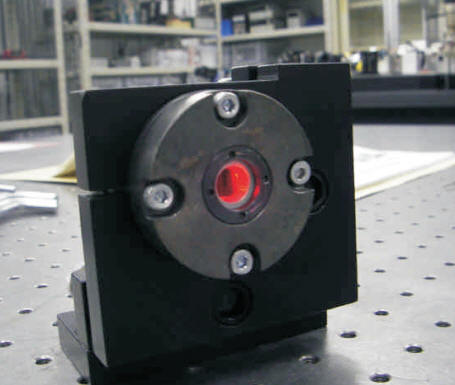
TIS-SF-777 laser support - e-mail or call us if you need support
Flagship model of 15-kHz-linewidth CW Ti:Sapphire laser TIS-SF-777
There may be two main reasons why laser power drops:Thick etalon adjustment schematics
Q1: Are these four screws for the adjustment ?
I tried to loosen one of these screws, but it was quite tight!
I felt a bit scary...
A1: yes, these are screws for etalon adjustment. They should be tight very well
in order
to keep etalon alignment during long time.

Q2: We irradiated an expanded, collimated He-Ne laser beam onto
the thick etalon with an angle shown by the bold red arrow in the picture below.
And we observed a fringe pattern on the reflected beam shown by the thinner
arrow in the same picture.
Do you think the thick etalon is too tilted against the incident beam?
A2: no, it should be some angle between input and reflected beams in order to
you
can observe a fringe pattern. So everything is OK. How many fringes you saw?
President and CEO of Tekhnoscan Sergey Kobtsev and President and CEO of Del
Mar Photonics Sergey Egorov
shaking hands after reaching partnership agreement during Photonics West 2007 in
San Jose, California
The standard tuning elements indicated below are used in CW Ti:Sapphire lasers such as Trestles CW or Trestles fs/CW.
Those elements are also sold separately as standrad items or as a custom made components.
1) Thick etalon -
request a quote
Thickness - 3 mm, diameter - 20 mm. Surface quality: Ð=1-2, N<1, ΔN<0.1,
λ/10, plane parallelism better than 10''. Thickness accuracy 5 um.
2) Thin etalon -
request a quote
Thickness - 200 um, diameter - 15 mm. Surface quality: Ð=1-2, N<1, ΔN<0.1,
λ/10, plane parallelism better than 10''. Thickness accuracy 5 um.
3) Birefringent filter BRF -
request a quote
Del Mar Photonics offers new Trestles fs/CW laser system which can be easily
switched from femtosecond mode to CW and back.
Having both modes of opeartion in one system dramatically increase a number of
applications that the laser can be used for, and makes it an ideal tool for
scientific lab involved in multiple research projects.
Typical specifications are:
Trestles fs/CW laser system
Ti:Sapphire femtosecond oscillator with CW operation option
Spatial mode: TEMoo;
Polarization: linear horizontal;
fs mode:
Tuning range (@10W pump): 750-850 nm;
Output power (@10W pump, 800 nm): >1500 mW;
Repetition rate: 80 MHz;
Pulse duration: <100 fs;
CW mode:
Tuning range (@10W pump): 750-850 nm;
Output power (@10W pump, 800 nm): >2000 mW in CW;
Linewidth (with two etalons): <2 GHz
Also included:
Thermostabilized breadboard;
Electronic starter with TTL output for mode-locked mode observation;
USB-controlled tuning slit for wavelength tuning in fs mode;
3-plate USB-controlled birefringent Lyot filter;
Two motorized USB-controlled etalons for linewidth control
Del Mar Photonics supply Trestles lasers as stand alone system, or as a
one-box system with built-in DPSS pump laser.
The price of the system with DPSS pump depends on required output power.
Request a quote - indicate required output power in your inquiry!